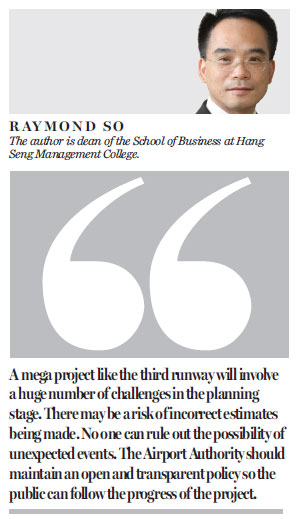Greater transparency needed for vital third runway project
Updated: 2015-10-08 08:51
By Raymond So(HK Edition)
|
|||||||
The financing arrangements for the third runway project of Hong Kong International Airport have recently received much attention. The Airport Authority Hong Kong (AA) last week announced a modified version of a construction fee levy program. This includes higher charges for business- and first-class passengers. This new suggestion will help reduce the burden on economy-class passengers. The new financing arrangements have also increased the amount of borrowing by the AA. From the authority's perspective, the new financial arrangements are feasible. However, the challenges ahead should not be overlooked. Solutions to these challenges may prove difficult in future. Many people have called the third runway a white elephant. Some concern groups believe it is not worth building at a cost of HK$140 billion. But the third runway is crucial for Hong Kong's future development. It is important to the livelihoods of millions of people.
Some people suggest Hong Kong has a mature economy which is still performing well. Therefore, we do not need more major investments in infrastructure. They argue that when Hong Kong's airport reaches its capacity, planes can always fly to other places in the Pearl River Delta (PRD), so there is no need to build another runway to increase capacity. The problem is that cities in the PRD are competing to be leading regional aviation hubs. This can bring them a lot of advantages. The establishment of international networks will boost an aviation hub, as well as bringing in additional business. Hong Kong is still the region's leading aviation hub. But if we just stick to the status quo, neighboring airports will catch up soon. The difficult thing is that once Hong Kong's leading position is gone it will be lost forever. This cold reality makes the third runway project essential.
Because of society's strong calls for environmental protection, the third runway needs to be built with these considerations in mind. A lot of technical difficulties are anticipated. The reclamation of land and new construction methods will definitely increase costs. Environmental protection always has a cost.
Collecting passenger surcharges is one way to cope with the high construction costs of the third runway. This is also a feasible solution. Air passengers are seldom concerned about various forms of surcharges. Surcharges like extra fuel charges and airport taxes are frequently levied without having much impact on the volume of air passengers. Imposing a higher surcharge on business- and first-class passengers makes it easier to sell the financing plan to the public. But in the current political climate, any increase in fares will be seen as a bad thing. However, the AA has proved before that it is good at handling these issues.
But, as mentioned above, the right financial arrangements will involve a lot of variables.
For a large infrastructure project, the biggest nightmare will be major unexpected changes in the construction parameters. The third runway will be built on reclaimed land. In handling a project of this size, the AA has to consider many important issues. For instance, key details such as the project's timetable and amount of financing needed all have to be carefully considered. The chance of delays in the project's completion and cost overruns will be high. But this is the risk every large project faces.
A mega project like the third runway will involve a huge number of challenges in the planning stage. There may be a risk of incorrect estimates being made. No one can rule out the possibility of unexpected events. The AA should maintain an open and transparent policy so the public can follow the progress of the project.

(HK Edition 10/08/2015 page10)